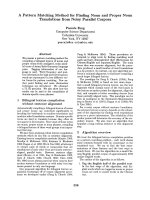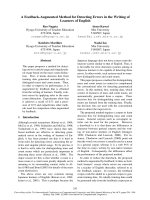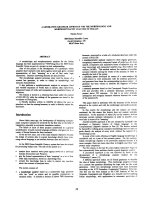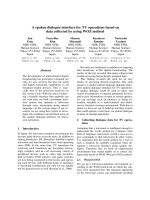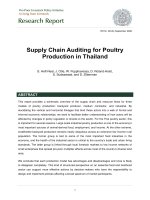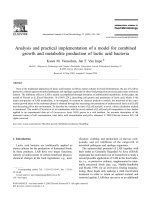Designing a supply chain Proposition for improving quality and overall productivity of enterprises using business model
Bạn đang xem bản rút gọn của tài liệu. Xem và tải ngay bản đầy đủ của tài liệu tại đây (13.91 MB, 113 trang )
DESIGNING A SUPPLY CHAIN: PROPOSITION FOR
IMPROVING QUALITY AND OVERALL
PRODUCTIVITY OF ENTERPRISES
USING BUSINESS MODEL
BY
SWAPNIL S. ANDHARE
B.E. (Mechanical), Nagpur University, India, 2006
THESIS
Submitted in partial fulfillment of the requirements for
the degree of Master of Science in Industrial and Systems Engineering
in the Graduate School of
Binghamton University
State University of New York
2010
UMI Number:
1480386
All rights reserved
INFORMATIO
N TO ALL USERS
The quality of this reproduction is dependent upon the quality of the copy submitted.
In the unlikely event that the author did not send a complete manuscript
and there are missing pages, these will be noted. Also, if material had to be removed,
a note will indicate the deletion.
UMI
1480386
Copyright 2
010 by ProQuest LLC.
All rights reserved. This edition of the work is protected against
unauthorized copying under Title 17, United States Code.
ProQuest LLC
789 East Eisenhower Parkway
P.O. Bo
x 1346
Ann Arbor, MI 48106-1346
© Copyright by Swapnil S. Andhare 2010
All Rights Reserved
iii
Accepted in partial fulfillment of the requirements for
the degree of Master of Science in Industrial and Systems Engineering
in the Graduate School of
Binghamton University
State University of New York
2010
May 06, 2010
Dr. Nagendra N. Nagarur, Chair and Faculty Advisor
Department of Industrial and Systems Engineering, Binghamton
University
Dr. Susan Lu
Department of Industrial and Systems Engineering, Binghamton
University
Dr. Eser Kirkizlar
Department of School of Management, Binghamton University
iv
ABSTRACT
Increasingly competitive and dynamic environment obligated top
management to bring uniqueness in the value proposition. Highly volatile
marketplace and innovation in products has put the business world on a
fast track but also reduced the product development time and product
life cycle. Globalization and current economy further increased the
pressure forcing companies to build a sound business model to combat
against the increasing competition. Thus, efficient and effective supply
chain design can potentially be the remedy for the above concerns.
One of the key issues in designing the supply chains is the identification
of key performance metrics. This research attempts to identify the critical
measures using a simplest, quantitative, consumer driven improvement
technique called as Quality Function Deployment (QFD).
A detailed case study explains the interactions between the business
model elements and supply chains performance metrics using QFD to
highlight the important measures, useful for deciding the supply chains
structures.
v
To my father Mr. Satishkumar, mother Ms. Sonali, brother-in-law
Mr. Amar and sister Ms. Sarika
vi
ACKNOWLEDGMENTS
M.S. from Systems Science and Industrial Engineering, Binghamton
University, NY was a wonderful experience and was a great journey that
helped me in inculcating a sense of professionalism through academic
knowledge, interactive activities, and practical industry exposure.
Primarily, I would like to proffer my greatest gratitude to Almighty Lord
and parents. I offer my sincerest thanks to my advisor, Dr. Nagendra
Nagarur, Chair, Department of Systems Science and Industrial
Engineering, for providing valuable advice, and guidance for my thesis,
research and throughout my graduate studies at Binghamton University.
As my advisor, his constant encouragement, patience, suggestions and
reviews certainly made the completion of this thesis possible.
I wholeheartedly thank my family, all my well-wishers and friends who
supported me in many ways to do my Masters from this prestigious
University
vii
TABLE OF CONTENTS
LIST OF FIGURES xii
LIST OF TABLES.xiv
CHAPTER 1 INTRODUCTION TO RESEARCH 1
1.1 INTRODUCTION 1
1.2 NEED FOR THE CHANGE 1
1.3 INTRODUCTION TO THE BUSINESS WORLD 3
1.4 SUPPLY CHAINS AND BUSINESS MODELS 3
1.5 ROLE OF A BUSINESS MODEL 5
1.6 SCOPE OF THE SUPPLY CHAIN 7
1.7 PROBLEM STATEMENT 8
1.8 RESEARCH OBJECTIVE 9
CHAPTER 2 LITERATURE REVIEW 10
2.1 ORIGINATION OF BUSINESS MODEL 10
2.2 PROGRESSION OF THE BUSINESS MODEL CONCEPT 12
viii
2.2.1 First phase: Definitions and classifications 12
2.2.2 Second phase (2000-2002): Citation of business model
elements/components 13
2.2.3 Third phase (2000-2003): Detailed explanation of each
element/component 13
2.2.4 Fourth phase (2004): Model formulation 13
2.2.5 Fifth phase: Application and implementation 13
2.3 KEY INGREDIENTS OF A BUSINESS MODEL 13
2.4 BUSINESS MODEL FRAMEWORK 14
2.4.1 Product innovation 15
2.4.2 Customer Interface 16
2.4.3 Infrastructure management 17
2.4.4 Financial aspects 19
2.5 THE BUSINESS TRIANGLE 19
2.5.1 Business strategy and business model interaction 20
2.5.2 Business organization and business model interaction 21
2.5.3 Technology and business model interaction 21
2.5.4 Environment and business model interaction 21
2.6 ROLE OF THE SUPPLY CHAINS 22
2.7 SUPPLY CHAIN DRIVERS 24
ix
2.7.1 Logistical drivers 25
2.7.2 Cross-functional drivers 26
2.8 SUPPLY CHAIN PERFORMANCE MEASURES 27
2.8.1 Strategic 28
2.8.2 Tactical 28
2.8.3 Operational 29
2.9 SUPPLY CHAIN STRATEGIES AND FIT 31
2.9.1 Lean supply chains 32
2.9.2 Agile supply chains 32
2.9.3 Hybrid supply chains 32
2.10 QUALITY FUNCTION DEPLOYMENT 37
2.10.1 Introduction 37
2.10.2 QFDs existence 37
2.10.3 Chronological development and implementation of QFD 38
2.11 QFD FRAMEWORK 39
2.11.1 First stage: Voice of customer (VOC) 40
2.11.2 Second stage: Competitive analysis 42
2.11.3 Third stage: Voice of the organization 43
2.11.4 Fourth stage: Design target level 43
2.11.5 Fifth stage: Relationship matrix 43
x
2.11.6 Sixth stage: Correlation matrix 44
2.12 QFD BENEFITS 45
2.13 QFD LIMITATIONS 45
CHAPTER 3 METHODOLOGY 46
3.1 INTRODUCTION 46
3.2 BUSINESS MODEL ELEMENTS - SUPPLY CHAIN COALITION 46
3.2.1 Phase I 49
3.2.2 Phase II 50
3.2.3 Phase III 54
3.2.4 Phase IV 61
CHAPTER 4 DETROIT MODEL - CASE STUDY 64
4.1 INTRODUCTION 64
4.2 DEVELOPMENT AND RAPID GROWTH OF THE “BIG THREE” 65
4.3 GREAT DEPRESSION: TRANSITION FROM THE “BIG THREE” TO THE
“DETROIT THREE” 66
4.4 QFD MODEL FORMATION 66
4.4.1 Notations 66
4.4.2 Model assumptions 67
4.5 MODEL STRUCTURE 68
4.5.1 Data collection 68
xi
4.5.2 Business model elements and performance measures House Of
Supply chain I 69
4.5.3 Calculations for ‘What’s’ 72
4.5.4 Service performance assessment 73
4.5.5 Calculations for How’s 76
4.6 MODEL ANALYSIS 80
4.6.1 Reality vs. Potential 80
4.7 CONCLUSION 88
CHAPTER 5 FUTURE RESEARCH 89
REFERENCES 91
xii
LIST OF FIGURES
Figure 2-1Evolution of business model concept (Osterwalder et al., 2005) 12
Figure 2-2 Four pillars and nine building blocks of the business model framework
(Osterwalder et al., 2005) 15
Figure 2-3 Business triangle: Business model and interactions (Osterwalder,
2004) 20
Figure 2-4 Ideal balanced supply chain (Stevens, 1989) 23
Figure 2-5 Competitive strategies and influence on supply chain design, (Mentzer
et al., 2001) 24
Figure 2-6 Supply chain drivers, (Chopra and Meindl, 2006) 25
Figure 2-7 Fisher’s product supply chain matrix, (Stavrulaki and Davis, 2010) 31
Figure 2-8 Leanness and agile supply chain matrix for demands, (Naylor et al.,
1999) 33
Figure 2-9 Market qualifiers and winners for lean and agile supply chains, (Jones
et al., 2000) 33
Figure 2-10 Supply chain strategies, (Naylor et al., 1999) 34
Figure 2-11 Sequential block diagram of QFD (Han et al., 2001) 40
Figure 2-12 Kano model analyses (Han et al., 2001) 41
Figure 2-13 House of Quality HOQ (QFD template, 2007) 44
xiii
Figure 3-1 Two different ways of designing the supply chain structure 48
Figure 3-2 Business model elements and supply chain coalition 49
Figure 3-3 Techniques and methods carried out during phase II 51
Figure 3-4 Customer Window Quadrant technique (Gonzalez et al., 2004, Han et
al., 2001) 53
Figure 3-5 QFD comprising of different stages/ HSC’s, (Bouchereau and
Rowlands, 2000) 55
Figure 3-6 QFD structure, (Kumar et al., 2006) 57
Figure 3-7 Correlation matrix, (QFD online, 2007) 61
Figure 4-1 ‘What’s’: Business elements and performance measures 70
Figure 4-2 Current supply chain strategy 83
Figure 4-3 Proposed supply chain strategy 87
xiv
LIST OF TABLES
Table 2-1 Supply chains performance measures, (Gunasekaran et al., 2001). 30
Table 2-2 Comparisons of supply chain characteristics, (Stavrulaki and Davis,
2010) 36
Table 3-1 Relationship table (Cohen, 1995) 59
Table 4-1 Competitive assessment and QFD calculation 74
Table 4-2 Service performance assessment 78
Table 4-3 Final QFD structure 79
Table 4-4 Brainstorming analysis Present vs. Future result, (Schwalm et al.,
2009) 81
1
CHAPTER 1
INTRODUCTION TO RESEARCH
1.1 INTRODUCTION
Now-a-days market trends are becoming more dynamic and volatile in nature
because of the globalization and rapid technological developments. Today’s
markets are more competitive as they pivot around customer requirements and
depend heavily upon time i.e. customer and time driven markets. Customers
expect high variety of reliable goods or services at lowest prices with best quality
and faster after sale services (Duclos, et al., 2003). To fulfill these low cost, high
responsive customer demands, companies have to focus on effective, efficient,
flexible and coordinated supply chains to increase profitability and customer
service levels (Sena, et al., 2004).
1.2 NEED FOR THE CHANGE
According to American business historians, business in America changed
drastically over the years from eighteenth century (Chandler, 1997). Traditional
American business was simple, single unit enterprise run by either a single
2
owner or small group of people. Because of this simplicity, the businesses were
normally dealt with a single assembly/ product line, fewer functions/ working
activities, small radius of transportation routes and more importantly, operated/
carried out from one single geographic area (Chandler, 1997).
In contrast, a modern enterprises/ business is much more complicated as it
operates at different locations, offers varied products and services to the
customers, thus internalizing all the activities within the organization/s. The
higher the number of interactions (people) and transactions (money, materials
etc.) across the hierarchy the more complex business can be (Chandler, 1997).
Changes in the business have brought changes in operational tactics as well. All
the decisions taken by the top management determine company’s success or
failure. One of the prime reasons behind industries failure, loss of market or loss
of revenue is the misbalance created between right products and right quantity of
products. Most of the time it is observed that industries are affected either by
stocking excess of unwanted products or by facing shortages of high demand
products i.e. failing to predict the nature of the demand correctly (Lewis and
Slack, 2003). Thus, decision making plays very dominant and prominent role in
shaping the future of any business. Striking a perfect balance between type of
products/services provided by the business and type of supply chain is the need
of the hour (Lewis and Slack, 2003).
3
1.3 INTRODUCTION TO THE BUSINESS WORLD
‘Business’ is not a new terminology. It have long been in existence however it’s
meaning, value and mode of operations changed significantly over the period of
time from ancient era (where businesses were mostly of exchanging goods or
services directly for other goods or services i.e. Barter system), to the present
internet era (Miller, 2008). Today we are living in an extremely competitive global
economic environment where the theory of ‘survival of the fittest’ holds good. In
the past all, the organizational decisions were dominated by an orthodox view of
managers purely based on their prior experience or sometimes on guts feeling.
These decisions generally used to be more dominated by two factors: Assets and
Resources (Walters, 2004).
1.4 SUPPLY CHAINS AND BUSINESS MODELS
The fundamental function of a business model is to generate revenue by adding
value and selling products to a larger market segment (Stevens, 1989). However,
with the emergence of new market trends and advancement in I.T., (Information
Technology) the business environment became extremely unpredictable,
unstable and indecisive (Osterwalder, 2004), where a company’s survival is not
merely based on existing assets and resources anymore but depends heavily on
flexible, coordinated supply chains, and collaborated business decisions and
strategies (Walters, 2004). During last few decades supply chains have gained
tremendous importance, people became aware of the long-term benefits of these
chains (Sena, et al., 2004). “Supply chain is a network of organizations that are
4
involved, through upstream (supplier) and downstream (distribution) linkages, in
the different processes and activities adding value from the raw material stage to
the final delivery stage to the different forms of products and services delivered to
the ultimate consumer” (Mentzer, et al., 2001). The two main functions of supply
chain are physical functions and market mediation. Physical functions are the
most talked functions in the supply chain as these basic functions include all the
activities from converting raw materials into finished goods, their transportation,
their storage, inventory etc., within different phases of supply chain. Mediation
functions on the other hand are those functions that make sure that right
products reach to right person in right time and in right amount. In order to be
competitive in this economy, companies have to meet the customers demand at
most cost-effective prices. If product supply is more than the market demand it
will add up cost related to physical functions such as production, transportation
and storage, or if the product life cycle is short then these supplies have to be
sold at cheaper rates and if the demands are not timely fulfilled then mediation
cost can be incurred which includes lost sales or lost revenues due to
discontented customers.
Globalization enabled a very competitive environment to foster which resulted in
emergence of new economy thus bringing a new approach towards building a
profitable and efficient business model (Walters, 2004). According to
Osterwalder, a business model can simply be defined as an “abstract conceptual
model representing the business and money earning logic of a company”
(Osterwalder, 2004).
5
In all the above aforementioned circumstances, companies cannot afford to lose
(Lewis and Slack, 2003). Hence, supply chain plays a key revolutionizing role
towards improving global market by becoming one of the most promising and
powerful strategic alliance with business model (Gunasekaran and Chung, 2004).
1.5 ROLE OF A BUSINESS MODEL
“Business model is the simplified representation of company’s business logic”.
However, this logic can sometimes be abstract concepts too, leading to
confusion. To avoid such scenarios a general value chain framework can be very
effective for model formulation. This can as well help managers to gauge,
understand, analyze and manage the business properly. Chesbrough, and
Rosenbloom (2000) and Osterwalder (2004) advocated that business model
have following eight functions that can also be considered as the potential use of
the business model:
• Recognize the market segment: Business model helps in identifying
current market trends, customer choices and their requirements etc.
• Characterize the value chain: Business model helps in defining the
series of activities and information that are essentially required to
design, produce, market, deliver and support company’s products or
services.
• Creating the unique competitive strategies: Globalization leads to
intense competition. The structured approach of the company must
allow them to compare their strategies with competitor’s strategies as it
6
will help in getting new insights about latest innovations and can as
well serve as indication of the competitor’s aggressive strategy.
• Fit: Business model aligns three entities of the business viz. strategy,
organization and technology by bridging the gaps between these three
entities.
• Evaluate: Business logic for any company cannot be permanent. It
changes over the time, because of many factors like competitive
forces, customer demands, technological changes etc. Business
models helps in analyzing the current strategies of the company and
helps in identifying pertinent measures to improve the business logic
by improving the current strategies, organization and technology.
• Envision: Visual representation of a business model can significantly
enhance human ability to understand complex processing information.
Conceptualization of model helps in improving the power of
imagination, which can open a new horizon of innovations.
• Communication and share: Good formulation of a business model is
of no use if not being communicated properly and correctly.
Formalizing and expressing it in more tangible way helps the
managers to communicate and share his/her views effectively among
other stakeholders within the business.
• Improve decision making: Good and effective communication and
information sharing within the organization that can lead towards better
and confident decision-making abilities.
7
1.6 SCOPE OF THE SUPPLY CHAIN
A supply chain is a network of activities that originates from the suppliers and
ends with the final customers, whereas, the scope of the supply chains sets up
with the source of supply and concludes at the end consumption (Stevens,
1989).
The objective of the supply chains is to maximize the business profit by
coordinating the customer demands with the value generated products supply via
its drivers viz. inventory, facilities, transportation, sourcing, and information.
Product flow (suppliers to the customers) and information flow (customers to the
suppliers) runs parallel across the supply chains, but in two opposite directions.
The tradeoff between the strategies based on efficiency and responsiveness are
often decided primarily on the products being offered: Functional or Innovative
(Stavrulaki and Davis, 2010), where former requires efficient supply chains
strategy and later requires responsive supply chains. Another important aspect of
the supply chains is the performance measures: Qualitative and Quantitative
(Beamon, 1998) which are useful in assessing the competitive strategies against
the competitors.
Variability and uncertainty in demands or supplies are the major cause of worries
for the supply chains (Hwarng and Xie, 2008). Therefore, having a balanced
supply chain is a key to company’s success. A successful supply chain should be
(Cohen and Roussel, 2005):
• Supportive to the business strategy;
8
• Targeted i.e. customer focused; and
• Flexible and adaptive to the market changes.
1.7 PROBLEM STATEMENT
One of the biggest and the greatest concerns in today’s business world is that of
the market sustainability and stability. For any business or organization to be
successful, it has to generate profits. Sustainability and stability brings
profitability in the business. In order to sustain and stabilize the business in the
dynamic market, a company has to meet customers demand regularly,
satisfactorily and economically. With growing pressure from customers and
competitors it is rather difficult for managers to recognize the important
performance measures to establish a striking alignment between customer
requirement and demand fulfillments i.e. finding a balance between
responsiveness and cost effectiveness in the supply chain. An efficient and
effective business model could have a huge and noteworthy impact on deciding
appropriate supply chain and reducing total working cost for the business.
The
second major hindrance is clarifying the myths and c
learing the ambiguity
regarding the business model among masses. Some of the other reasons that
contribute towards the selection of a business model for designing a supply chain
include:
• A business model is the most commonly used terminology in business
world yet so misunderstood by the masses (Osterwalder, et al., 2005);
9
• It provides an architectural framework which will enable managers to
visualize, understand and analyze the business properly (Osterwalder,
2004);
• Very difficult to predict or forecast the future trends of business-making
decisions due to rapid change in customer demands and expectations;
and,
• Very simple and effective tool for formulating the business strategies.
1.8 RESEARCH OBJECTIVE
The research attempts to explore the concept of business model in detail and
focus on its applicability in designing an efficient supply chain employing Quality
Function Deployment (QFD).
• To study business model in depth including its conceptual evolution, its
framework, and classification;
• To study supply chains metrics, drivers in details;
• To study and apply the concept of Quality Functional Deployment
(QFD) technique, to build a House of Supply chain (HSC) matrix by
establishing a relationship, between a business model elements and
supply chain performance metrics;
• In effect, this research aims to identify critical performance metrics
from the business model using Quality Function Deployment (QFD)
technique to achieve the strategic fit between competitive priorities and
supply chain design elements.
10
CHAPTER 2
LITERATURE REVIEW
2.1 ORIGINATION OF BUSINESS MODEL
The concept of a business model has gained momentum and witnessed
tremendous growth within last few decades (Osterwalder et al., 2005). However,
Bellman, Clark et al., (1957) were the first researchers to use the term “business
model” in an academic article. Three years later in 1960 researcher Jones
introduced this term in the title and the abstract of his paper (Osterwalder et al.,
2005), and since then the popularity of business models never faded. More and
more researches are being carried out and publications are being written on the
foundations of the previous research. In 2007 authors, Makinen and Seppanen
conducted a key search of exact term ‘business model’ on website and found
that there were more than 277 scholarly articles directly related to the underlying
concept (Makinen and Seppanen, 2007). Besides business, it has received even
greater attention in myriad domains, such as academics, management, I.T.,
strategy building etc (Osterwalder, 2004). Success of Mc Donald’s food
restaurants, Toyota, Wal-Mart, Dell computer, Fed Ex, Amway, eBay, and
